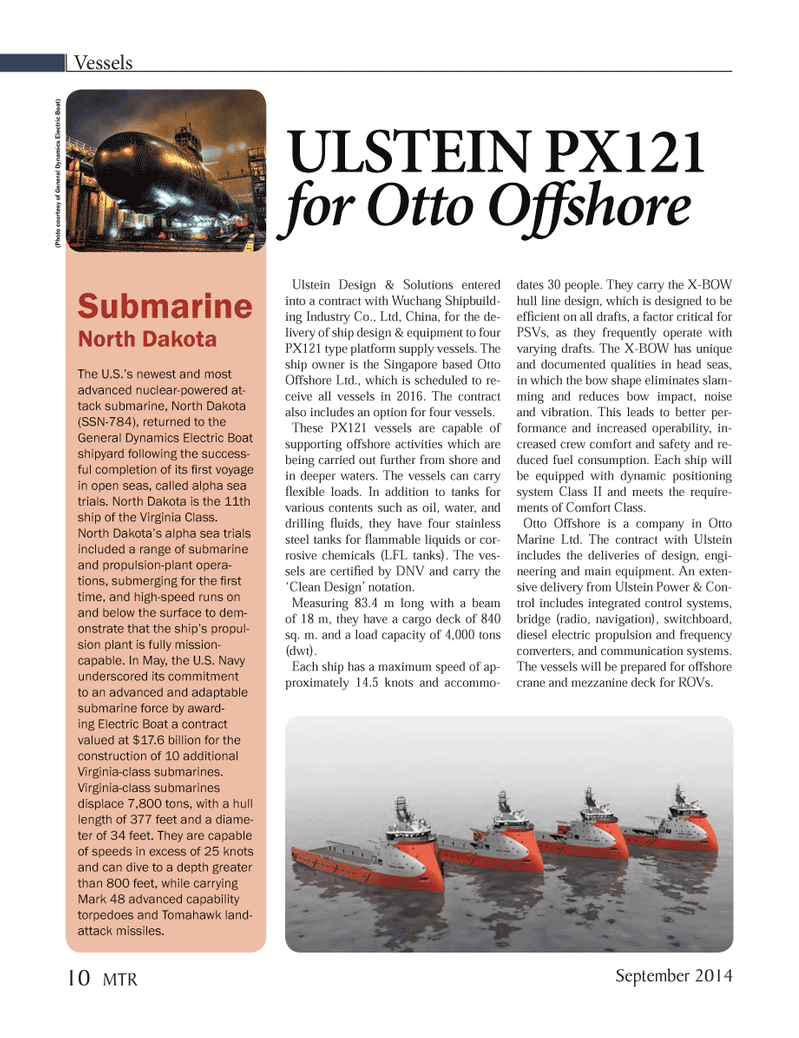
Page 10: of Marine Technology Magazine (September 2014)
Ocean Observation: Gliders, Buoys & Sub-Surface Networks
Read this page in Pdf, Flash or Html5 edition of September 2014 Marine Technology Magazine
Vessels
Submarine
North Dakota
The U.S.’s newest and most advanced nuclear-powered at- tack submarine, North Dakota (SSN-784), returned to the
General Dynamics Electric Boat shipyard following the success- ful completion of its fi rst voyage in open seas, called alpha sea trials. North Dakota is the 11th ship of the Virginia Class.
North Dakota’s alpha sea trials included a range of submarine and propulsion-plant opera- tions, submerging for the fi rst time, and high-speed runs on and below the surface to dem- onstrate that the ship’s propul- sion plant is fully mission- capable. In May, the U.S. Navy underscored its commitment to an advanced and adaptable submarine force by award- ing Electric Boat a contract valued at $17.6 billion for the construction of 10 additional
Virginia-class submarines.
Virginia-class submarines displace 7,800 tons, with a hull length of 377 feet and a diame- ter of 34 feet. They are capable of speeds in excess of 25 knots and can dive to a depth greater than 800 feet, while carrying
Mark 48 advanced capability torpedoes and Tomahawk land- attack missiles.
Ulstein Design & Solutions entered into a contract with Wuchang Shipbuild- ing Industry Co., Ltd, China, for the de- livery of ship design & equipment to four
PX121 type platform supply vessels. The ship owner is the Singapore based Otto
Offshore Ltd., which is scheduled to re- ceive all vessels in 2016. The contract also includes an option for four vessels.
These PX121 vessels are capable of supporting offshore activities which are being carried out further from shore and in deeper waters. The vessels can carry fl exible loads. In addition to tanks for various contents such as oil, water, and drilling fl uids, they have four stainless steel tanks for fl ammable liquids or cor- rosive chemicals (LFL tanks). The ves- sels are certifi ed by DNV and carry the ‘Clean Design’ notation.
Measuring 83.4 m long with a beam of 18 m, they have a cargo deck of 840 sq. m. and a load capacity of 4,000 tons (dwt).
Each ship has a maximum speed of ap- proximately 14.5 knots and accommo- dates 30 people. They carry the X-BOW hull line design, which is designed to be effi cient on all drafts, a factor critical for
PSVs, as they frequently operate with varying drafts. The X-BOW has unique and documented qualities in head seas, in which the bow shape eliminates slam- ming and reduces bow impact, noise and vibration. This leads to better per- formance and increased operability, in- creased crew comfort and safety and re- duced fuel consumption. Each ship will be equipped with dynamic positioning system Class II and meets the require- ments of Comfort Class.
Otto Offshore is a company in Otto
Marine Ltd. The contract with Ulstein includes the deliveries of design, engi- neering and main equipment. An exten- sive delivery from Ulstein Power & Con- trol includes integrated control systems, bridge (radio, navigation), switchboard, diesel electric propulsion and frequency converters, and communication systems.
The vessels will be prepared for offshore crane and mezzanine deck for ROVs. (Photo cour tesy of General Dynamics Electric Boat)
ULSTEIN PX121 for Otto Off shore
September 2014 10 MTR
MTR #7 (1-17).indd 10 8/27/2014 11:09:13 AM

 9
9

 11
11
